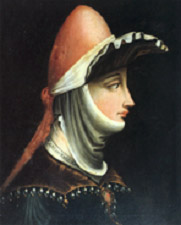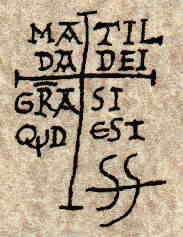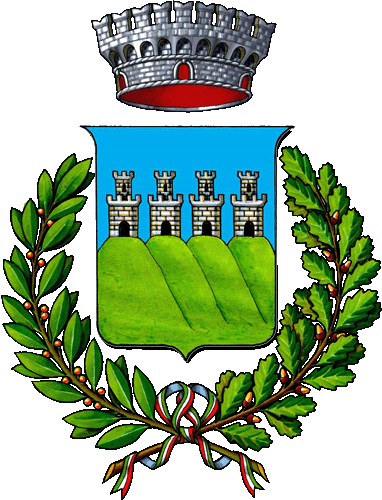Matilde di Canossa

 Figura femminile di grande importanza nella storia del Medioevo europeo, Matilde di Canossa a soli sei anni si ritrova erede di un territorio che andava dagli odierni dal Lazio fino al Lago di Garda, strategico perché punto di passaggio obbligato sia per i Pontefici che dovevano insediarsi a Roma, sia per gli imperatori che a Roma dovevano essere incoronati.
Figura femminile di grande importanza nella storia del Medioevo europeo, Matilde di Canossa a soli sei anni si ritrova erede di un territorio che andava dagli odierni dal Lazio fino al Lago di Garda, strategico perché punto di passaggio obbligato sia per i Pontefici che dovevano insediarsi a Roma, sia per gli imperatori che a Roma dovevano essere incoronati.
Seconda cugina dell’imperatore Enrico IV, ma fedele seguace della Riforma della Chiesa portata avanti da Papa Gregorio VII, si ritrova al centro di uno scontro epocale per la lotta delle investiture tra Papato e Impero.
Per motivi politici si sposa con Goffredo il Gobbo e dovrà lasciare le sue terre per insediarsi nella patria del marito, la Lorena. Il matrimonio ha fine dopo pochi anni e Matilde potrà tornare dalla madre Beatrice in territorio italiano.
Assiste così all’inasprimento delle divergenze tra Papa Gregorio VII e l’imperatore Enrico IV, il primo deciso ad imporre la supremazia del papato su ogni potere terreno, il secondo pronto alla guerra per far valere i suoi diritti di sovrano assoluto.
Dopo la scomunica di Enrico IV, Matilde farà da mediatrice tra il sovrano ribelle e il papa presso il castello di Canossa, mostrando la sua ambivalenza dovuta alla fedeltà verso il cugino imperatore e il desiderio di essere una buona cristiana
L’umiliazione di Enrico IV è solo una mossa strategica di convenienza e la lotta riprenderà a breve.
Per il suo ruolo di intermediaria Matilde viene spogliata del titolo di Contessa e privata delle sue terre: è una donna sola, alcuni vassalli le si ribellano e, per difendere il suo feudo sotto attacco delle truppe imperiali, contrae un secondo matrimonio, anche questo infelice e fallimentare.
Solo nel 1111, con l’accordo di Bianello, le viene nuovamente riconosciuto il potere sui suoi domini e viene incoronata Vicaria Imperiale in Italia da parte del nuovo imperatore Enrico V. In cambio garantisce al tedesco l’eredità di tutte le sue proprietà.
Solo negli ultimi anni della sua esistenza Matilde potrà dedicarsi alla preghiera e alla religione tralasciata in gioventù per il suo ruolo politico.
Morirà vicino al tanto amato monastero di San Benedetto in Polirone e dal 1632 riposa a Roma nella basilica di San Pietro
Matilde di Canossa
A female figure of great importance in the history of the European Middle Ages, Matilde di Canossa (Matilda of Tuscany) at the age of six finds herself the heir of a territory that went from today’s Lazio to Lake Garda, strategic because it was a mandatory passageway for both the popes who had to settle in Rome, and the emperors that were to be crowned there.
Second cousin of Emperor Henry IV, but a faithful follower of the Reformation of the Church carried out by Pope Gregory VII, she finds herself at the center of an epochal clash for the investiture struggle between the Papacy and the Empire.
For political reasons she marries Goffredo il Gobbo and will have to leave her lands to settle in her husband’s homeland, Lorraine. The marriage ends after a few years and Matilda will be able to return to her mother Beatrice in Italian territory.
Thus she witnesses the worsening of differences between Pope Gregory VII and Emperor Henry IV, the first determined to impose the supremacy of the Papacy over every earthly power, the second ready for war to assert his rights as absolute sovereign.
After the excommunication of Henry IV, Matilda will act as mediator between the rebel sovereign and the pope at the castle of Canossa, showing her ambivalence due to loyalty to her cousin Emperor and the desire to be a good Christian. The humiliation of Henry IV is only a strategic move of convenience and the fight will resume shortly.
For her role as intermediary Matilda is stripped of the title of Countess and deprived of her lands: she is a woman, alone. Some vassals rebel against her and, to defend her fiefdom under attack by the imperial troops, she contracts a second marriage, also unhappy and bankruptcy.
Only in 1111, with the agreement of Bianello, the power over her domains was recognized again and she was crowned Imperial Vicar in Italy by the new Emperor Henry V. In exchange, she guaranteed the inheritance of all her properties to the German.
Only in the last years of her existence Matilda will be able to devote herself to prayer and to religion, which she neglected in her youth for her political role. She will die near the much loved monastery of St. Benedict in Polirone, and since 1632 she rests in Rome, in the church of St. Peter.


